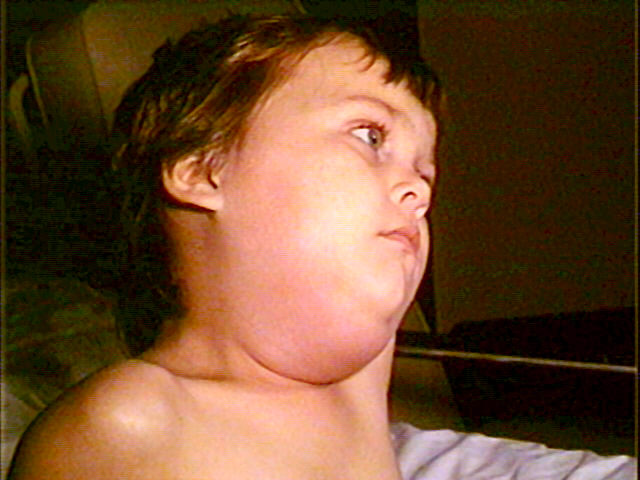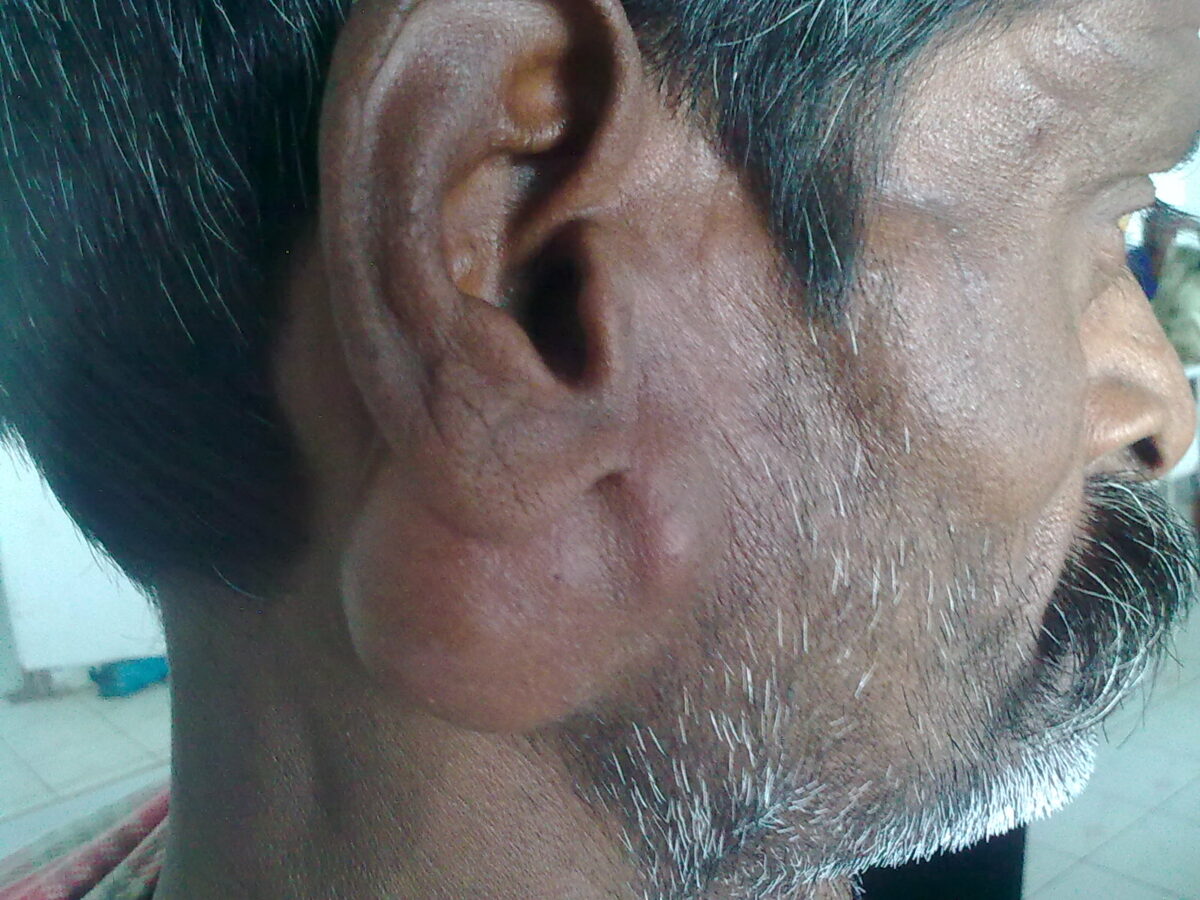Diseases of the salivary glands Salivary glands The salivary glands are exocrine glands positioned in and around the oral cavity. These glands are responsible for secreting saliva into the mouth, which aids in digestion. There are 3 major paired salivary glands: the sublingual, submandibular, and parotid glands. Salivary Glands: Anatomy include sialadenosis, sialadenitis, sialolithiasis, and neoplasms Neoplasms New abnormal growth of tissue. Malignant neoplasms show a greater degree of anaplasia and have the properties of invasion and metastasis, compared to benign neoplasms. Benign Bone Tumors. Sialadenosis is a chronic, bilateral, noninflammatory hypertrophy Hypertrophy General increase in bulk of a part or organ due to cell enlargement and accumulation of fluids and secretions, not due to tumor formation, nor to an increase in the number of cells (hyperplasia). Cellular Adaptation of the salivary glands Salivary glands The salivary glands are exocrine glands positioned in and around the oral cavity. These glands are responsible for secreting saliva into the mouth, which aids in digestion. There are 3 major paired salivary glands: the sublingual, submandibular, and parotid glands. Salivary Glands: Anatomy. Sialadenitis results from inflammation Inflammation Inflammation is a complex set of responses to infection and injury involving leukocytes as the principal cellular mediators in the body's defense against pathogenic organisms. Inflammation is also seen as a response to tissue injury in the process of wound healing. The 5 cardinal signs of inflammation are pain, heat, redness, swelling, and loss of function. Inflammation or infection of the glands, and sialolithiasis is due to stone formation in the glands or ducts. Neoplasms Neoplasms New abnormal growth of tissue. Malignant neoplasms show a greater degree of anaplasia and have the properties of invasion and metastasis, compared to benign neoplasms. Benign Bone Tumors of the salivary gland may be benign Benign Fibroadenoma or malignant. All of these conditions manifest as salivary gland enlargement. Other clinical factors help differentiate these conditions, such as symmetry, the presence of pain Pain An unpleasant sensation induced by noxious stimuli which are detected by nerve endings of nociceptive neurons. Pain: Types and Pathways, associated conditions and risk factors, and growth or stability. The diagnosis is often clinical, though imaging and biopsy Biopsy Removal and pathologic examination of specimens from the living body. Ewing Sarcoma may be needed. Management varies depending on the disease.
Last updated: Jan 31, 2023

Diagram depicting the location of the major salivary glands and their ducts
Image: “2408 Salivary Glands” by OpenStax College. License: CC BY 3.0The major salivary glands Salivary glands The salivary glands are exocrine glands positioned in and around the oral cavity. These glands are responsible for secreting saliva into the mouth, which aids in digestion. There are 3 major paired salivary glands: the sublingual, submandibular, and parotid glands. Salivary Glands: Anatomy produce > 95% of an individual’s saliva Saliva The clear, viscous fluid secreted by the salivary glands and mucous glands of the mouth. It contains mucins, water, organic salts, and ptyalin. Salivary Glands: Anatomy.

Diagram displaying the differences in ion movement between the acinar cells (in charge of secretion) and the ductal cells (in charge of reabsorption)
Image by Lecturio.Since sialadenosis, sialadenitis, and sialithiasis are similar-appearing names, understanding the suffix may aid in differentiating the underlying process.
Sialadenosis (sialosis) is a chronic, benign Benign Fibroadenoma, noninflammatory hypertrophy Hypertrophy General increase in bulk of a part or organ due to cell enlargement and accumulation of fluids and secretions, not due to tumor formation, nor to an increase in the number of cells (hyperplasia). Cellular Adaptation of the salivary glands Salivary glands The salivary glands are exocrine glands positioned in and around the oral cavity. These glands are responsible for secreting saliva into the mouth, which aids in digestion. There are 3 major paired salivary glands: the sublingual, submandibular, and parotid glands. Salivary Glands: Anatomy.
Patients Patients Individuals participating in the health care system for the purpose of receiving therapeutic, diagnostic, or preventive procedures. Clinician–Patient Relationship will present with enlarged salivary glands Salivary glands The salivary glands are exocrine glands positioned in and around the oral cavity. These glands are responsible for secreting saliva into the mouth, which aids in digestion. There are 3 major paired salivary glands: the sublingual, submandibular, and parotid glands. Salivary Glands: Anatomy with the following characteristics:

Bilateral parotid gland swelling due to sialadenosis (sialosis)
Image: “Buccal alterations in diabetes mellitus” by Negrato CA, Tarzia O. License: CC BY 2.0No treatment is needed, other than addressing the underlying medical condition.
Sialadenitis is inflammation Inflammation Inflammation is a complex set of responses to infection and injury involving leukocytes as the principal cellular mediators in the body’s defense against pathogenic organisms. Inflammation is also seen as a response to tissue injury in the process of wound healing. The 5 cardinal signs of inflammation are pain, heat, redness, swelling, and loss of function. Inflammation or infection of the salivary glands Salivary glands The salivary glands are exocrine glands positioned in and around the oral cavity. These glands are responsible for secreting saliva into the mouth, which aids in digestion. There are 3 major paired salivary glands: the sublingual, submandibular, and parotid glands. Salivary Glands: Anatomy.

A child with salivary gland swelling due to mumps
Image: “Mumps PHIL 130 lores” by CDC/NIP/Barbara Rice. License: Public Domain
Submandibular swelling and erythema due to sialadenitis
Image: “Acute submandibular sialadenitis-a case report” by Chandak R, Degwekar S, Chandak M, Rawlani S. License: CC BY 3.0The diagnosis is clinical. An evaluation can be done if the diagnosis is uncertain or to determine an etiology:
General measures:
For bacterial infection:
Sialolithiasis is the formation of calculi within the salivary glands Salivary glands The salivary glands are exocrine glands positioned in and around the oral cavity. These glands are responsible for secreting saliva into the mouth, which aids in digestion. There are 3 major paired salivary glands: the sublingual, submandibular, and parotid glands. Salivary Glands: Anatomy or ducts.

Salivary gland stone (sialolithiasis)
Image: “Salivary gland stone removed” by Peternickson. License: CC0 1.0
X-ray demonstrating a massive opacity (arrow) consistent with sialolithiasis
Image: “Massive Submandibular Sialolith: Complete Radiographic Registration and Biochemical Analysis through X-Ray Diffraction” by Franco, A., et al. License: CC BY 3.0The following are risk factors for malignant salivary tumors:

Firm nodule originating from the parotid gland. The nodule in this photograph is from a pleomorphic adenoma, a benign salivary gland neoplasm.
Image: “Parotid Tumour” by N. Raveender. License: Public Domain
Round pleomorphic adenoma located on the hard palate
Image: “Incidence and prevalence of salivary gland tumours in Valparaiso, Chile” by Araya J, Martinez R, Niklander S, Marshall M, Esguep A. License: CC BY 2.5, cropped by Lecturio.
Mucoepidermoid carcinoma of the right parotid gland
Image: “Diseases of the salivary glands in infants and adolescents” by Ellies M, Laskawi R. License: CC BY 2.0
Intraoral swelling that extends to the left second molar due to adenoid cystic carcinoma of the palate.
Image: “Adenoid cystic carcinoma of the palate: case report and review of literature” by The Pan African Medical Journal. License: CC BY 2.0
CT of neck soft tissue demonstrates an enhancing mass (white arrow) within the left parotid gland. No enlarged lymph nodes or abnormal fluid collections are seen.
Image: “An unusual initial presentation of mantle cell lymphoma arising from the lymphoid stroma of warthin tumor” by Arcega RS, Feinstein AJ, Bhuta S, Blackwell KE, Rao NP, Pullarkat ST. License: CC BY 4.0